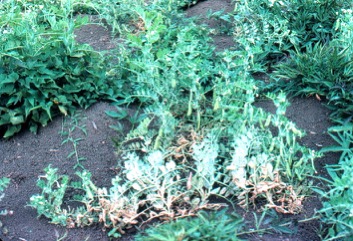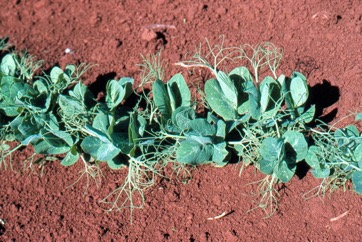Pea

A temperate plant. Plants grow best at altitudes over 1000 m in the tropics. They suit a humid climate. Hot dry weather interferes with seed setting. They are frost tolerant except at flowering. A temperate plant. They need temperatures of 13°C to 18°C. They need a pH of 5.5-6.5 and reasonably good fertility. They cannot tolerate waterlogging or very acid soils. They grow to 4,400 m altitude in the Himalayas. It suits hardiness zones 7-9.
Also known as:
Alverja, Amu bola kadala, Aveja, Batagadle, Batani, Chana, Chicharo, Endou mame, Erbse, Ercis, Ervilha, Gartenerbse, Guisante, He lan dou, Kacang manis, Kachhe, Keraun, Keyagu, Matar, Mattar, Patanlu, Pattani, Pe-leikpya, Pe-sa-u, Pe-si-lon, Pisello, Pisu, Pois, Sadawpe, San-too-see, Satila, Sitsaro, Thua lantao, Tian wan dou, To-kam, Tsing tau, Wan dou, Wandu, Wan-du-si, Watani
Synonyms
- Pisum hortense Aschers. & Graebn.
- Lathyrus oleraceus Lam.
- Pisum vulgare Jundz.
Edible Portion
- Seeds, Pods, Leaves, Vegetable, Flowers
Where does Pea grow?
Found in: Afghanistan, Africa, Albania, Algeria, Argentina, Armenia, Asia, Australia, Austria, Azerbaijan, Balkans, Bangladesh, Belgium, Bhutan, Britain, Bulgaria, Burundi, Cambodia, Canada, Caucasus, Central Africa, Central America, Central Asia, Chile, China, Colombia, Congo, Cuba, Cyprus, Czech Republic, Dominican Republic, East Africa, East Timor, Egypt, Eritrea, Ethiopia, Europe, Fiji, Finland, France, Georgia, Germany, Gibraltar, Greece, Greenland, Guatemala, Haiti, Hawaii, Himalayas, India, Indochina, Indonesia, Iran, Iraq, Israel, Italy, Japan, Jordan, Kazakhstan, Kenya, Korea, Kyrgyzstan, Laos, Lebanon, Libya, Lithuania, Macedonia, Madagascar, Malawi, Malaysia, Marianas, Mauritius, Mediterranean, Mexico, Moldova, Mongolia, Morocco, Mozambique, Myanmar, Nepal, Netherlands, New Zealand, Niger, Nigeria, North Africa, North America, Northeastern India, Norway, Pacific, Pakistan, Papua New Guinea, PNG, Peru, Philippines, Portugal, Romania, Russia, Rwanda, Saudi Arabia, Scandinavia, SE Asia, Serbia, Sikkim, Slovenia, South Africa, Southern Africa, South America, Spain, Sri Lanka, Sudan, Sweden, Switzerland, Syria, Taiwan, Tajikistan, Tanzania, Tasmania, Thailand, Timor-Leste, Tonga, Tunisia, Turkey, Uganda, Ukraine, Uruguay, United States, Vanuatu, Vietnam, West Africa, West Indies, Yugoslavia, Zambia, Zimbabwe
Notes: There are 2 Pisum species.
Status: It is a commercially cultivated vegetable. Gaining importance in some highlands areas in the tropics. About 20 million tons of peas are grown each year worldwide.
Growing Pea
Cultivation: Plants are grown from seed. Seed can be collected for re-sowing. A spacing about 5 cm apart in rows 25 cm apart is suitable. Seed can be 3-5 cm deep. If rotting is a problem, plants can be supported off the ground. Plants need inoculation with bacteria for good production. For dried peas plants are cut when mature then dried and threshed.
Edible Uses: Mostly the young seeds are eaten. They can be eaten raw or cooked. Sometimes the young pods and leaves are eaten. The flowers are eaten in salads. The sprouted seeds are eaten. The young leaves and buds are cooked as a vegetable. The dry seeds are eaten. They are used in soups and stews and ground into flour. Roasted seeds are used as a substitute for coffee.
Nutrition Info
per 100g edible portion| Edible Part | Energy (kcal) | Protein (g) | Iron (mg) | Vitamin A (ug) | Vitamin c (mg) | Zinc (mg) | % Water |
|---|---|---|---|---|---|---|---|
| Seed - raw | 68 | 5.8 | 1.9 | 300 | 25 | 0.7 | 78.5 |
| Seed - boiled | 53 | 5 | 1.2 | 300 | 15 | 0.5 | 80 |
| Leaves | - | - | - | 89 | - | - |
Pea Photos





References
Ali, A. M. S., 2005, Homegardens in Smallholder Farming Systems: Examples from Bangladesh. Human Ecology, Vol. 33, No. 2 pp. 245-270
Al-Qura'n, S. A., 2010, Ethnobotanical and Ecological Studies of Wild Edible Plants in Jordan. Libyan Agriculture Research Center Journal International 1(4):231-243
Ambasta, S.P. (Ed.), 2000, The Useful Plants of India. CSIR India. p 463
Anderson, E. F., 1993, Plants and people of the Golden Triangle. Dioscorides Press. p 218
Ara, R. I. T., 2015, Leafy Vegetables in Bangladesh. Photon eBooks. p 81
Bernholt, H. et al, 2009, Plant species richness and diversity in urban and peri-urban gardens of Niamey, Niger. Agroforestry Systems 77:159-179
Bianchini, F., Corbetta, F., and Pistoia, M., 1975, Fruits of the Earth. Cassell. p 40
Blamey, M and Grey-Wilson, C., 2005, Wild flowers of the Mediterranean. A & C Black London. p 92
Bodkin, F., 1991, Encyclopedia Botanica. Cornstalk publishing, p 805
Burkill, H. M., 1985, The useful plants of west tropical Africa, Vol. 3. Kew.
Burkill, I.H., 1966, A Dictionary of the Economic Products of the Malay Peninsula. Ministry of Agriculture and Cooperatives, Kuala Lumpur, Malaysia. Vol 2 (I-Z) p 1788
Bussman, R. W., et al, 2016, A comparative ethnobotany of Khevsureti, Samtskhe-Javakheti, Tusheti, Svaneti, and Racha-Lechkhumi, Republic of Georgia (Sakartvelo), Caucasus. Journal of Ethnobiology and Ethnomedicine (2016) 12:4
Bussman, R. W. et al, 2017, Ethnobotany of Samtskhe-Javakheti, Sakartvelo (Republic of Georgia), Caucasus. Indian Journal of Traditional Knowledge Vol. 16(1) pp 7-24
Cheifetz, A., (ed), 1999, 500 popular vegetables, herbs, fruits and nuts for Australian Gardeners. Random House p 90
Chin, H. F., 1999, Malaysian Vegetables in Colour. Tropical Press. p 76
Cundall, P., (ed.), 2004, Gardening Australia: flora: the gardener's bible. ABC Books. p 1054
Davies, D.R., 1979, Peas, in Simmonds N.W.,(ed), Crop Plant Evolution. Longmans. London. p 172
Facciola, S., 1998, Cornucopia 2: a Source Book of Edible Plants. Kampong Publications, p 109
Foo, J.T.S.(ed), 1996, A Guide to Common Vegetables. Singapore Science Foundation. p 92
Fowler, D. G., 2007, Zambian Plants: Their Vernacular Names and Uses. Kew. p 39
French, B.R., 1986, Food Plants of Papua New Guinea, A Compendium. Asia Pacific Science Foundation p 42
French, B.R., 2010, Food Plants of Solomon Islands. A Compendium. Food Plants International Inc. p 56
Grubben, G. J. H. and Denton, O. A. (eds), 2004, Plant Resources of Tropical Africa 2. Vegetables. PROTA, Wageningen, Netherlands. p 413
Hadfield, J., 2001, The A-Z of Vegetable Gardening in South Africa. Struik p 115
Hedrick, U.P., 1919, (Ed.), Sturtevant's edible plants of the world. p 503
Hermandez Bermejo, J.E., and Leon, J. (Eds.), 1994, Neglected Crops. 1492 from a different perspective. FAO Plant Production and Protection Series No 26. FAO, Rome. p 299
Hu, Shiu-ying, 2005, Food Plants of China. The Chinese University Press. p 480
ILDIS Legumes of the World http:www:ildis.org/Legume/Web
Jabeen, A., et al, 2009, Indigenous uses of economically important flora of Margallah Hills National Park, Islamabad, Pakistan. African Journal of Biotechnology Vol. 8 (5), pp. 763-784
Jardin, C., 1970, List of Foods Used In Africa, FAO Nutrition Information Document Series No 2.p 28, 95
Kays, S. J., and Dias, J. C. S., 1995, Common Names of Commercially Cultivated Vegetables of the World in 15 languages. Economic Botany, Vol. 49, No. 2, pp. 115-152
Khodram,S. D., et al, 2019, Local knowledge of edible flowers used in Mizoram. Indian Journal of Traditional Knowledge Vol 18(40 pp 715-723
Kiple, K.F. & Ornelas, K.C., (eds), 2000, The Cambridge World History of Food. CUP p 1830
Kumar, A., et al, 2012, Ethnobotanical Edible Plant Biodiversity of Lepcha Tribes. Indian Forester, 138 (9):798-803
Larkcom, J., 1991, Oriental Vegetables, John Murray, London, p 106
Lazarides, M. & Hince, B., 1993, Handbook of Economic Plants of Australia, CSIRO. p 191
Macmillan, H.F. (Revised Barlow, H.S., et al), 1991, Tropical Planting and Gardening. Sixth edition. Malayan Nature Society. Kuala Lumpur. p 367
Manandhar, N.P., 2002, Plants and People of Nepal. Timber Press. Portland, Oregon. p 367
Martin, F.W. & Ruberte, R.M., 1979, Edible Leaves of the Tropics. Antillian College Press, Mayaguez, Puerto Rico. p 200
Medhi, P. & Borthakur, S. K., 2012, Phytoresources from North Cachur Hills of Assam -3: Edible plants sold at Hflong market. Indian Journal or Natural Products and Resources. 3(1) pp 84-109
Molares, S. & Ladio, A., 2012, The Usefulness of Edible and Medicinal Fabaceae in Argentine and Chilean Patagonia: Environmental Availability and Other Sources of Supply. Evidence-Based Complementary and Alternative Medicine. Volume 2012, Article ID 901918, 12 pages, Hindawi Publishing Corporation.
Molla, A., Ethiopian Plant Names. http://www.ethiopic.com/aplants.htm
Ochse, J.J. et al, 1931, Vegetables of the Dutch East Indies. Asher reprint. p 421
Pena, F. B., et al, 1998, Los quelites de la Sierra Norte de Puebla, Mexico: Inventory Y Formas de Preparacion. Bol. Soc. Bot. Mexico 62:49-62
Pham-Hoang Ho, 1999, An Illustrated Flora of Vietnam. Nha Xuat Ban Tre. p 979
Plants for a Future database, The Field, Penpol, Lostwithiel, Cornwall, PL22 0NG, UK. http://www.scs.leeds.ac.uk/pfaf/
Plants of Haiti Smithsonian Institute http://botany.si.edu/antilles/West Indies
Polunin, O., & Stainton, A., 2006, Flowers of the Himalaya, Oxford India Paperbacks. p 102
Purseglove, J.W., 1968, Tropical Crops Dicotyledons, Longmans. p 311
Ruiters-Welcome, A. K., 2019, Food plants of southern Africa. Ph.D. thesis. Univ. of Johannesburg p 59
Shah, S. K., 2014, Dietary contribution of underutilized minor crops and indigenous plants collected from uncultivated lands and forests in Nepal. in Promotion of Underutilized Indigenous Food Resources for Food Security and Nutrition in Asia and Pacific. FAO. Bangkok p 64
Sharma, B.B., 2005, Growing fruits and vegetables. Publications Division. Ministry of Information and broadcasting. India. p 201
Sillitoe, P. 1995, An Ethnobotanical Account of the Plant Resources of the Wola Region, Southern Highlands Province, Papua New Guinea. J. Ethnobiol. 15(2): 201-235
Small, E., 2009, Top 100 Food Plants. The world's most important culinary crops. NRC Research Press. p 401
Solomon, C., 2001, Encyclopedia of Asian Food. New Holland. p 209
Song, M., et al, 2013, Traditional knowledge of wild edible plants in Jeju Island, Korea. Indian Journal of Traditional Knowledge. 12(2) pp 177-194
Sp. pl. 2:727. 1753
Staples, G.W. and Herbst, D.R., 2005, A tropical Garden Flora. Bishop Museum Press, Honolulu, Hawaii. p 321
Terra, G.J.A., 1973, Tropical Vegetables. Communication 54e Royal Tropical Institute, Amsterdam, p 67
Tindall, H.D., 1983, Vegetables in the Tropics, Macmillan p 284
USDA, ARS, National Genetic Resources Program. Germplasm Resources Information Network - (GRIN). [Online Database] National Germplasm Resources Laboratory, Beltsville, Maryland. Available: www.ars-grin.gov/cgi-bin/npgs/html/econ.pl (10 April 2000)
van Wyk, B., 2005, Food Plants of the World. An illustrated guide. Timber press. p 300
Verdcourt, B., 1979, Manual of New Guinea Legumes. Botany Bulletin No 11, Division of Botany, Lae, Papua New Guinea. p 562
Vickery, M.L. and Vickery, B., 1979, Plant Products of Tropical Africa, Macmillan. p 22
Williamson, J., 2005, Useful Plants of Malawi. 3rd. Edition. Mdadzi Book Trust. p 202
Yeshi, K. et al, 2017, Taxonomical Identification of Himalayan Edible Medicinal Plants in Bhutan and the Phenolic Contents and Antioxidant Activity of Selected Plants. TBAP 7 (2) 2017 pp 89 - 106
Zhang, L., et al, 2016, Ethnobotanical study of traditional edible plants used by the Naxi people during droughts. Journal of Ethnobiology and Ethnomedicine. 12:39